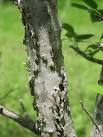Hackberry Tree Information
Images of Hackberry:






Hackberry grows in the following 14 states and provinces:
Arizona, California, Colorado, Idaho, Kansas, Maine, Nebraska, Nevada, New Mexico, Oklahoma, Oregon, Texas, Utah, WashingtonInformation about Hackberry:
The Celtis Reticulata is commonly known as the Hackberry, Netleaf Hackberry, Palo Blanco, Sugarberry as well as Western Hackberry.
The scientific name of netleaf hackberry is Celtis reticulata Torr. . Netleaf hackberry is a highly variable and taxonomically confusing species . Hybridization is common within the genus Celtis and most species are poorly defined . Intergrading forms and ecotypic variants are common . Some authorities consider netleaf hackberry to be a variant of sugarberry (Celtis laevigata) and still others place it in synonymy with Douglas hackberry (C. douglasii) . However, many taxonomists now regard it as a discrete species . Netleaf hackberry readily hybridizes with sugarberry and populations with intermediate characteristics have been reported . Some authorities delineate two forms of netleaf hackberry on the basis of leaf size . Still others recognize many intergrading forms . According to Kearney and others , "it is highly probable that more than one species is included ... as Celtis reticulata, but pending thorough revision of North American species of Celtis, no other treatment seems practicable." Biosystematic revision has been suggested for the tribe Celteae .Netleaf hackberry grows throughout scattered portions of the Great Basin, Pacific Northwest, and Southwest . Its range extends from southern Nebraska south through central Kansas and Colorado into Texas and northern Mexico , westward to southern California, and north through Washington and Oregon into Idaho .Netleaf hackberry grows as an overstory dominant or codominant in a number of communities, including riparian woodlands of the Southwest and narrow gallery forests of eastern Washington and west-central Idaho. Common codominants include live oak (Quercus virginiana), cedar elm (Ulmus crassifolia), cheatgrass (Bromus tectorum), bluebunch wheatgrass (Pseudoroegneria spicata), and sand dropseed (Sporobolus cryptandrus). Published classifications listing netleaf hackberry as a dominant or indicator in community types (cts), habitat types (hts), or plant associations (pas) are presented below. Area Classification Authority w-c ID grassland and shrubland Tisdale 1986b hts, cts w-c ID, e WA riparian cts Miller and Johnson 1986 OK western oak cts Dooley and Collins 1984 OR, ID: Wallowa general veg. pas Johnson and Simon 1987 e WA, n ID steppe hts Daubenmire 1970aSome of the information provided here is attributed to:Tirmenstein, D. A. 1990. Celtis reticulata. In: Fire Effects Information System, [Online]. U.S. Department of Agriculture, Forest Service, Rocky Mountain Research Station, Fire Sciences Laboratory (Producer). , available at the USDA Fire Effects Information System (FEIS) website